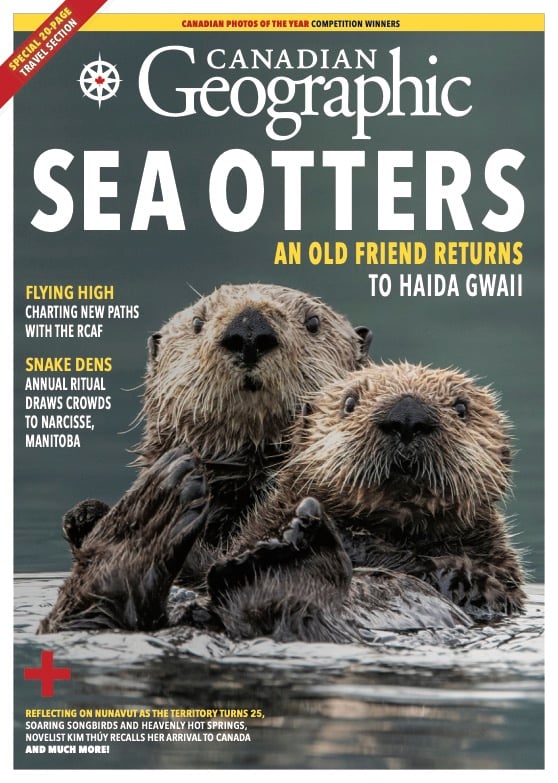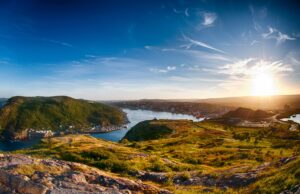
Science & Tech
20 Canadian innovations you should know about
Celebrating Canadian Innovation Week 2023 by spotlighting the people and organizations designing a better future
- 3327 words
- 14 minutes
History
Fredericton, home to the William Brydone Jack Observatory, will be one of the few Canadian cities to experience the total solar eclipse that crosses North America on April 8

Crowded by trees on the oldest part of the University of New Brunswick’s Fredericton campus sits a two-storey octagonal tower clad in white clapboard. Students hustle past, likely unaware of its status as Canada’s first astronomical observatory. Today, the William Brydone Jack Observatory has fallen into disuse, but when it opened in 1851 this national historic site was one of the most advanced observatories of its time, and Jack a pioneer in the development of Canadian astronomy.
An amateur astronomer and founding member of the William Brydone Jack Astronomy Club, Don Kelly is a wealth of information about the accomplishments of the astronomer, engineer and teacher who dedicated his career to this observatory. As he tours me around, he rhymes off Jack’s accomplishments.

Born in Scotland in 1817, Jack graduated from the University of St. Andrews and was recruited in 1840 by King’s College (as UNB was then known) as professor of mathematics and natural philosophy. He would spend the next 45 years lobbying for, building, then equipping his observatory, all the while recruiting students and bringing the province into the 19th century.
Within seven years of his appointment, Jack convinced college leaders to approve the purchase of a state-of-the-art refracting telescope. His colleague James Robb wrote to lieutenant governor William Colebrooke that, because of the provincial capital’s geographic location, “the great Climate influences… Temperature, Humidity, Pressure, Electricity are free to exhibit themselves in forms more simple and unmodified than at most other places.”
The colonial government also chipped in. Thomas Baillie, surveyor general of New Brunswick, warned the Lieutenant Governor, “Numerous lawsuits are daily springing up out of the looseness of the old surveys upon which the first [land] grants were made.” An observatory was necessary to establish a meridian line as the permanent, unchanging base for drawing boundaries and borders. In other words, the observatory would not just be a tool meant for observing the stars, but would also be used to to settle disputes between neighbouring landowners, claim territory that was ripe for commercial exploitation and assert sovereignty over Indigenous lands.
Jack travelled to Massachusetts to tour Harvard University’s observatory and gather advice on the design and equipment. Upon his return, he designed his observatory with a rotating, copper-roofed dome that could be turned by a single person. Inside was a two-metre refracting telescope of mahogany and brass, made by the best in the business, Merz and Sons of Munich.
On three evenings in 1855, Jack made history, taking precise measurements of nine telegraph signals sent by colleagues at the Harvard College Observatory and calculating Fredericton’s exact longitude relative to Boston. The two observatories also compared readings as first one, then the other passed beneath a chosen star. Feeding the data into a formula, Jack mapped Fredericton’s exact longitudinal location: 4 hours, 26 minutes, 33.43 seconds west of Greenwich, England, the prime meridian. With Fredericton’s longitude accurately established, Jack then determined the longitudinal locations for almost 40 other towns across New Brunswick.

The province and surveyors now had baselines to draw accurate boundaries. Following Jack’s recommendations, the province standardized surveying equipment and insisted surveyors pass rigorous tests. Jack laid out a length of surveying chain at the university, the length of which all surveyors had to match. The chain is still there. By 1859, the year King’s College became UNB, New Brunswick had its first modern map.
Rummaging among scattered artefacts, Kelly uncovers a box of slides painted with constellations, comets and eclipses. Boxes of these slides in hand, Jack would travel to schools and temperance halls around the province, using a lantern to project the images onto walls.“Jack was trying to recruit bright, young kids to the university to educate themselves and further science,” says Kelly.
In 1861, Jack was appointed UNB’s second president. While in the role, he advocated for women in higher education and the establishment of faculties of law and medicine. In his back yard, he set up a weather station that would be used by Canada’s meteorological services into the 20th century, while at the observatory, he focused on researching comets until his death in 1886.
On April 8, Fredericton will be one of a handful of Canadian cities to experience the full, total eclipse; if Jack were around today, you’d likely find him at his namesake observatory, shoulder to shoulder with his fellow students of the sky awaiting this captivating celestial event.
Are you passionate about Canadian geography?
You can support Canadian Geographic in 3 ways:

This story is from the March/April 2024 Issue

Science & Tech
Celebrating Canadian Innovation Week 2023 by spotlighting the people and organizations designing a better future

Travel
Discovering boats, buoys and deep-fried clams on an epic family road trip in the 2022 Chevrolet Traverse RS

Travel
Immerse yourself in Viking archaeology and Basque whaling history while taking in Newfoundland’s scenic coastline and incredible geology

People & Culture
As the climate heats up, so do talks over land ownership in the Arctic. What does Canadian Arctic Sovereignty look like as the ice melts?